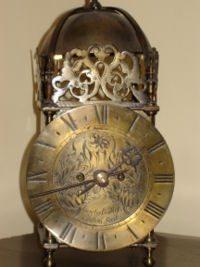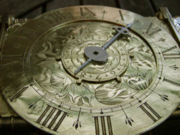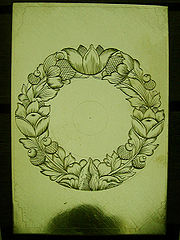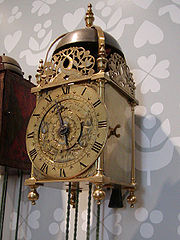
Lantern clock
Encyclopedia

Wall
A wall is a usually solid structure that defines and sometimes protects an area. Most commonly, a wall delineates a building and supports its superstructure, separates space in buildings into rooms, or protects or delineates a space in the open air...
clock
Clock
A clock is an instrument used to indicate, keep, and co-ordinate time. The word clock is derived ultimately from the Celtic words clagan and clocca meaning "bell". A silent instrument missing such a mechanism has traditionally been known as a timepiece...
, shaped like a lantern
Lantern
A lantern is a portable lighting device or mounted light fixture used to illuminate broad areas. Lanterns may also be used for signaling, as 'torches', or as general light sources outdoors . Low light level varieties are used for decoration. The term "lantern" is also used more generically to...
. They were the first type of clock widely used in private homes. They probably originated before 1500 but only became common after 1600; in Britain
Early Modern Britain
Early modern Britain is the history of the island of Great Britain, roughly corresponding to the 16th, 17th, and 18th centuries. Major historical events in Early Modern British history include the English Renaissance, the English Reformation and Scottish Reformation, the English Civil War, the...
around 1620. They became obsolete in the 19th century.
Origin of the name
There are two theories of the origin of the name 'lantern clock'. One is that the name derived from the shape; the clock resembles a rectangular lantern of that period, and like a lantern was hung on the wall. The other is that it refers to brass, the main metal of which lantern clocks are made. Copper alloys, of which brass is one, were often called latten in earlier times and 'lantern' could be a corruption of this old word. In inventories of deceased clock makers, lantern clocks usually are simply referred to as 'house clocks', 'chamber clocks' or just 'clocks', since in 17th century England they were almost the only type of domestic clocks that existed. It was only after a century had passed, when other types of domestic clocks began to be used in British houses, that more descriptive names for it appeared. Other names used for these clocks are bedpost, birdcage or Cromwellian clocks. 'Sheep's head clock' was a fashionable term for a certain type of lantern clock that had an extremely large chapter ring covering almost the entire front.Origin of Lantern Clocks
The English lantern clock is closely related to lantern clocks that can be found on the European continent. Most likely a group of craftsmen from the Low Lands (Flanders) and France, of which some were clock makers, had established themselves in London at the end of the 16th century. At the same time the middle classes in towns and cities of England began to prosper slowly and a need for a new phenomenon arose: the domestic clock. Until that time clocks in English houses were confined to the nobility and ordinary people were dependent on the tower clocks of the local churches.
Style characteristics
Lantern clock were made almost completely in brassBrass
Brass is an alloy of copper and zinc; the proportions of zinc and copper can be varied to create a range of brasses with varying properties.In comparison, bronze is principally an alloy of copper and tin...
, whereas most earlier clocks had been constructed from iron and wood. Typical lantern clocks comprised a square
Square (geometry)
In geometry, a square is a regular quadrilateral. This means that it has four equal sides and four equal angles...
case on ball or urn
Urn
An urn is a vase, ordinarily covered, that usually has a narrowed neck above a footed pedestal. "Knife urns" placed on pedestals flanking a dining-room sideboard were an English innovation for high-style dining rooms of the late 1760s...
feet, a large circular
Circular
Circular is a basic geometric shape such as a Circle.Circular may also refer to:-Documents:*Circular note, a document request by a bank to its foreign correspondents to pay a specified sum of money to a named person...
dial (with a chapter ring extending beyond the width of the case on early examples), a single hour hand, and a large bell
Bell (instrument)
A bell is a simple sound-making device. The bell is a percussion instrument and an idiophone. Its form is usually a hollow, cup-shaped object, which resonates upon being struck...
and finial
Finial
The finial is an architectural device, typically carved in stone and employed decoratively to emphasize the apex of a gable or any of various distinctive ornaments at the top, end, or corner of a building or structure. Smaller finials can be used as a decorative ornament on the ends of curtain rods...
. The clocks usually had ornate pierced fretwork
Fretwork
Fretwork is an interlaced decorative design that is either carved in low relief on a solid background, or cut out with a fretsaw, coping saw, jigsaw or scroll saw. Most fretwork patterns are geometric in design. The materials most commonly used are wood and metal. Fretwork is used to adorn...
on top of the frame.
The main style characteristics of English lantern clocks are similar to its Continental relatives. In brief: a wall clock with square bottom and top plates surmounted by a large bell, four corner pillars, a series of vertical plates positioned behind each other and a 30-hour movement with one or more weights. The English variant has some specific details that will be discussed in the next paragraphs. At the start of the 17th century the style gradually evolved to a standard to which all clockmakers more or less complied. The guild supervised the clockmakers who were compelled to work within a prescribed method. Suppliers to the clockmakers' trade contributed to this general style as well. For example the brass founders supplied stylistically identical clock posts to several clock makers. In contrast to the Dutch variants, such as stool clocks, English lantern clocks were entirely made of metal (brass and steel).
Lantern clocks were originally weight driven, usually one weight for the time keeping and a second for striking. A few modern lantern-style clocks were constructed with spring mechanisms and many surviving examples of the original weight-driven type have been converted to spring or pendulum mechanisms.
Guild system
In only a few decades the lantern clock became very popular in London and from there its popularity spread to the entire country. This is derived from the vast quantity of lantern clocks that still exist. Dozens of clockmakers produced great numbers of these clocks in the city of London during the 17th century. This huge productivity was the result of the high demand for this popular clock in combination with an effective guildGuild
A guild is an association of craftsmen in a particular trade. The earliest types of guild were formed as confraternities of workers. They were organized in a manner something between a trade union, a cartel, and a secret society...
system. In 1631 King Charles I granted a charter for a clockmaker guild in London: the Worshipful Company of Clockmakers
Worshipful Company of Clockmakers
The Worshipful Company of Clockmakers is one of the Livery Companies of the City of London. The Clockmakers were formed by a Royal Charter in 1631. Originally, no person was allowed to sell clocks unless they were a member of the Company. However, such requirements have since been relaxed and later...
, which exists to this day. Many of the well known clock makers from that era were freemen of this guild. Many small companies were established in Lothbury in London that functioned as suppliers for the clockmakers. A clockmaker could benefit from the services of, for example, brass founders who supplied cast brass clock parts, dial plates, finials, pillars, frets etcetera or employ engravers who would carry out the engraving of the dial plates and frets. The guild assured the quality of the products that left the clockmakers' workshops. Before a clockmaker could become a freeman, able to set up his own shop, he had to spend 7 years as an apprentice learning the trade. This insured independent clockmakers a plentiful supply of apprentices, who in fact were cheap labourers that helped to attain this high productivity.

Influence of the Renaissance
Style characteristics were copied from prints that were available for craftsmen. Under the influence of the Renaissance, prints with motives and patterns from the Classical antiquity found their way to the workshops. They served as examples for the clock pillars that were inspired by columns from Greek temples. During the 17th century the tulip became very popular to an extent of a real tulip mania. Prints with pictures of tulips were a rewarding subject for the adornment of the dial plates of lantern clocks. In the early 17th century lantern clocks got their characteristic shape which hardly changed during the 17th and halfway through the next century as a result of all this.
Clock parts
The London Clockmakers equipped their lantern clocks with four pillars that were inspired by classical columns. Attached to these pillars are classical vase-shaped finials and well-shaped feet. To those finials a bell strap is attached that spreads from four corners and holds a bell. To hide the hammer and the clock movement from the spectator three frets are attached to the finials. The front fret is pierced and is engraved whereas the two side frets are pierced but usually left blank. The front of the clock case consists of an engraved dial plate on which a circular dial ring is attached. Almost all lantern clocks have just one clock hand, the one that indicates the hours. A standard lantern clock only strikes the hours on a large bell and is often equipped with an alarm that rings the same bell. Two doors provide access to the movement and are hinged at the sides of the clock. One or more weights are hanging from ropes or chains at the bottom of the clock.
Obsolescence
Lantern clocks were produced in vast numbers during the decades before the pioneering invention of the pendulum by the Dutch scientist Christiaan Huygens in 1656. Before this invention, lantern clocks used a balance wheelBalance wheel
The balance wheel is the timekeeping device used in mechanical watches and some clocks, analogous to the pendulum in a pendulum clock. It is a weighted wheel that rotates back and forth, being returned toward its center position by a spiral spring, the balance spring or hairspring...
lacking a balance spring
Balance spring
A balance spring, or hairspring, is a part used in mechanical timepieces. The balance spring, attached to the balance wheel, controls the speed at which the wheels of the timepiece turn, and thus the rate of movement of the hands...
for their timekeeping element, which limited their accuracy to perhaps 15 minutes per day. Shortly after Huygens' invention, the bob pendulum was introduced in England, and most English clockmakers adopted the new system quickly. The pendulum increased the accuracy of clocks so greatly that existing clocks were converted, with pendulums being added to the back. Measuring time became much more accurate but clockmakers kept building most lantern clocks without minute hands. The reason for this isn't obvious, maybe it was just a matter of tradition. The result was, among other reasons such as the burden of pulling clock weights daily, that clockmakers started to develop other types of domestic clocks. Longcase clocks with 8-day movements made lantern clocks obsolete and gradually lantern clocks disappeared from the London interiors in the first decades of the 18th century. In rural areas lantern clocks were produced until the beginning of the 19th century and in those years they were even exported to countries like Turkey. In the Victorian era there was a revival of interest for the, by then, antique lantern clocks. Unfortunately this also meant that many clocks of renowned makers were stripped of their movements, which were replaced by 'modern' winding movements. Nowadays (almost) untouched lantern clocks are very rare.

